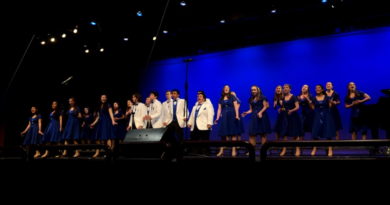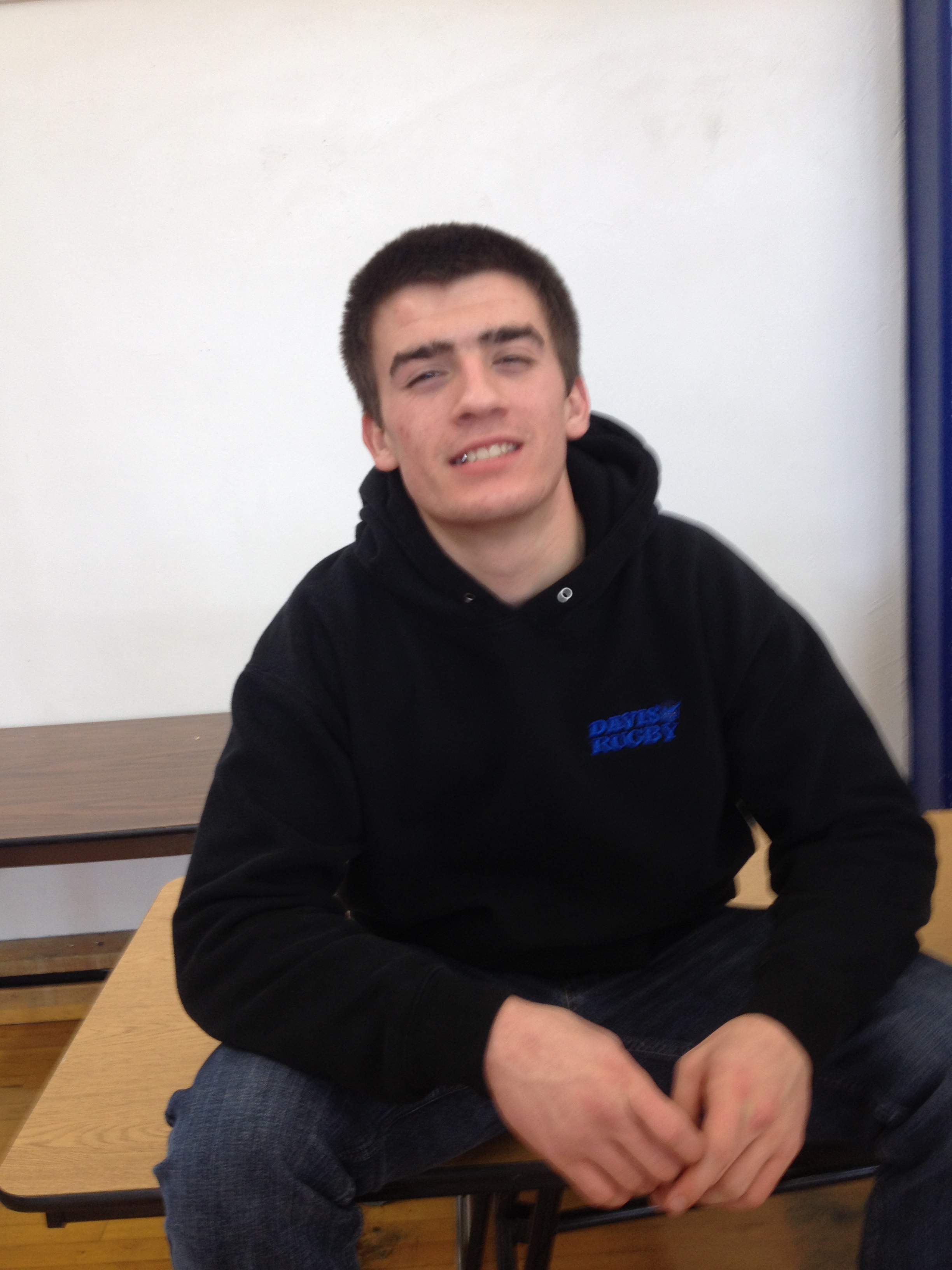For the tenth year in a row Citrus Circuits dominates at Worlds
PHOTO: Yi Zhang, Emma Zhao and Jack Ringgold return from match one of Sacramento Regionals.
By Gwynn Canfield
BlueDevilHUB.com Staff–
46 Blue Devils left for Houston on April 17—and returned with 3rd place on the world stage.
The Citrus Circuits 1678 robotics team continued a decade of dominance at the 2024 FIRST Robotics World Championships from April 17-20. Their success stemmed from hard work that began in January, when the 2024 competition game was released.
The Game
1678 is one of approximately 3600 teams in the 2024 FIRST (For the Inspiration and Recognition of Science and Technology) Robotics Competition (FRC).
Each team programs and builds its own robot. The robot is then used in a complex field game against other competitors.
However, this field game changes every year, meaning each season imposes a unique challenge upon participants.
This year’s game, music-themed and dubbed “CRESCENDO,” involves picking up orange rings, or notes, and shooting them into targets around the field.
A “speaker shot” earns a straightforward two points, while hitting an “amplifier” twice provides the team with two options.
They can select an end game bonus, which can boost the team’s ranking in the competition, or they can choose to ‘amplify’ their speaker for ten seconds, which makes speaker shots worth five points instead.
The match concludes with an ‘end game.’ Robots must climb a structure in the middle of the field via a chain and drop a note into the slot at the top.
Although the difficulty of climbing the chain poses a challenge, especially for more inexperienced teams, this movement is one of 1678’s strengths.
“We are one of the best teams in the world that consistently gets that every single time,” electrical subteam member Sarah Oschner-Hembrow said. “That helps us move up in the competition.”
Additionally, matches are alliance-based, with each side consisting of three robotics teams who work together to earn more points than their opposing alliance.
To deal with the complexity of the annual FRC game, a descriptive game manual is released.
The 2024 manual contains 153 pages of information, including requirements for the robot and the extensive rules of “CRESCENDO”.
“We read (the manual) thoroughly and then we sit down and have a brainstorm about what attributes we want our robot to have,” 1678 founder Steve Harvey said. “For example, we wanted to be able to hang on the chain, but also score in the (slot).”
Once the team is set on their desired components, they create possible robot designs and prototypes.
“All of the different (attributes) that we’re going to have on the robot dictates the design,” Harvey said.
The Robot
Similarly to other FRC teams, 1678 splits its members into seven different subteams, each playing a key role in competition preparation: Design, Fabrication, Electrical, Software Robot, Software Scouting (Front-end and Back-end) and Business & Media.
Design is the first subteam to begin work on the robot, using an online platform called Onshape to design each individual piece. “We have dimension restraints for everything,” Design member Jack Ringgold said. “From there, we start to flesh out what (the robot) is going to look like.”
Design then makes part drawings and sends them across the building to the shop, where Fabrication members get to work using the high-tech array of lathes, mills and routers to make each individual robot part.
These machines were introduced with the opening of the robotics building, a new addition to the DHS campus in April of 2023.
“(The machines) are industry standard and very fancy, which is exciting that I get to know how to use them as a high schooler,” Fabrication member Cleah Sronce said.
The building’s size has also allowed the team to be more efficient. “More people can work at once, (allowing) us to be more productive and streamlined,” Fabrication member Mason Terrazas said.
Once the individual parts are constructed, they are returned to the hands of Design, who assembles the robot.
“It really lets you see all the work you’ve done,” Design member Seb Waters said. “Seeing the physical (product) in front of you is a really rewarding experience.”
The robot’s shell is then brought to life by Electrical, who attaches wires, motors and other electrical components that allow the robot to move.
“It’s super hands on and problem solving (oriented),” Electrical member Olivia Niemela said. “Electrical always has the same process, which I really like.”
The final step regarding robot production lies in the code of Software Robot, who assures that all electronics inside the robot function properly.
Additionally, during the first 15 seconds of each FRC match, the robot operates autonomously, meaning it depends on code written by the Software Robot subteam to move.
The team goes through this process multiple times over the course of the season, making adjustments based on its performance in each competition. This season, 1678 had four iterations called Alpha, Beta, Epsilon and Comp, respectively.
“We’re always replacing things on (the robot), seeing how we can make things more accurate and efficient, and just making it the best it can possibly be,” Oschner-Hembrow said.
As the season goes on, the team shifts most of its attention to its official competition robot, Comp. “Our focus (is) narrowed down to just one robot that we need to make sure is as great as it can be,” Waters said.
Backstage
The remaining three subteams–Software Scouting (Front-end or Back-end) and Business & Media–do not work directly on the robot, but are still essential to the team’s performance.
When FRC teams are highly seeded in a competition, they may be granted the role of alliance captain, which has the ability to select its own alliance partners.
When provided with this opportunity, teams rely on their Software Scouting subteams. Scouts collect competition data, such as which teams are best at scoring or defense. Coupled with data analysis, the most cohesive alliance partners for 1678 become apparent.
While Back-End is responsible for the data collection and analysis, Front-End develops an app that allows this data to be both readily available and easy to interpret.
“Usually we end up seeding pretty high and we’re able to pick our alliance partners, so we want to make sure they’re the best match,” Back-End Lead Rohaan Sandhu said.
Additionally, through 1678’s website, social media, fliers and advertisements, the Business & Media subteam helps showcase the team’s performance to the rest of the FRC community.
They are also in charge of the team’s budget, allocating portions to each respective subteam.
“We try to prepare documentation to best show the public what we did this (season),” Business & Media Lead Dennis Cha said. “We try to cover basically everything that happens.”
The World Championship
All of this work is done with the FRC World Championship in mind. Teams can qualify in three ways: winning a regional event, earning the Impact Award or being granted a wild card.
The Impact Award is given to the team who best embodies the mission of FRC, while wild cards are given by teams who have already qualified for Worlds once.
1678 qualified for Worlds three different times this season – by winning the Silicon Valley and EastBay Regionals and by earning the Impact Award.
At Worlds, teams are divided into eight different divisions, where they compete in division playoffs. Alliances are also made up of four teams instead of three.
Each division’s winning alliance moves on to the Einstein Field, the winner of which is crowned the FRC champion. “You have to go in with no expectations since there’s a lot of luck involved,” Ringgold said. “You just go in and give your best effort and see what happens.”
1678 and its alliance successfully won the Archimedes division, cementing 1678’s 10-year streak of reaching Einstein. “No other team has ever accomplished this,” 1678 captain Steven Zhang said.“Being able to maintain that consistency is something I’m very proud of.”
Although 1678 ultimately ranked 3rd in the Einstein Field, they topped the statistical field with 60 Expected Points Added (EPA). This metric measures the amount of points a robot is expected to score in an FRC match.
“It’s a calculation, so it’s not exactly perfect, but I’m happy to say that we had one of the best robots in the world,” Zhang said.




